Hand Hygiene Name of the student: An Australian university
VerifiedAdded on 2021/06/14
|9
|2502
|124
AI Summary
Researchers are of the opinion that hospital acquired infections, especially the urinary tract infections, MRSA infections, surgical site infections and respiratory infections in the cardiac arrest or stroke patients are contributing factors to enhanced mortality in the patients due to their frail and immune-compromised state due to the burden of the burden of the disease (Huttner et al., 2013). (2014), health care associated infections or the HCAIs comprises of central line associated bloodstream infections, catheter-associated urinary tract infections, ventilator-
Contribute Materials
Your contribution can guide someone’s learning journey. Share your
documents today.
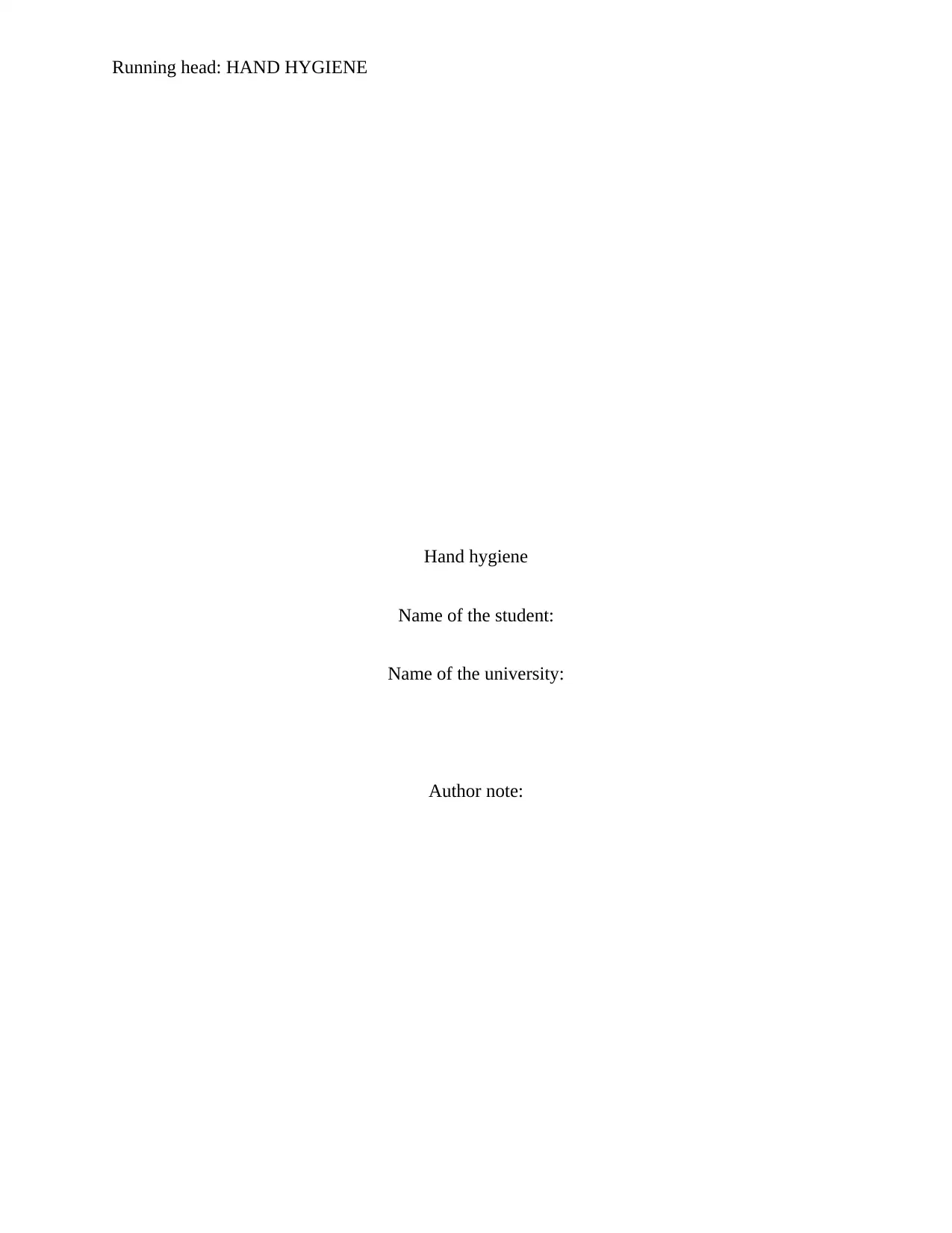
Running head: HAND HYGIENE
Hand hygiene
Name of the student:
Name of the university:
Author note:
Hand hygiene
Name of the student:
Name of the university:
Author note:
Secure Best Marks with AI Grader
Need help grading? Try our AI Grader for instant feedback on your assignments.
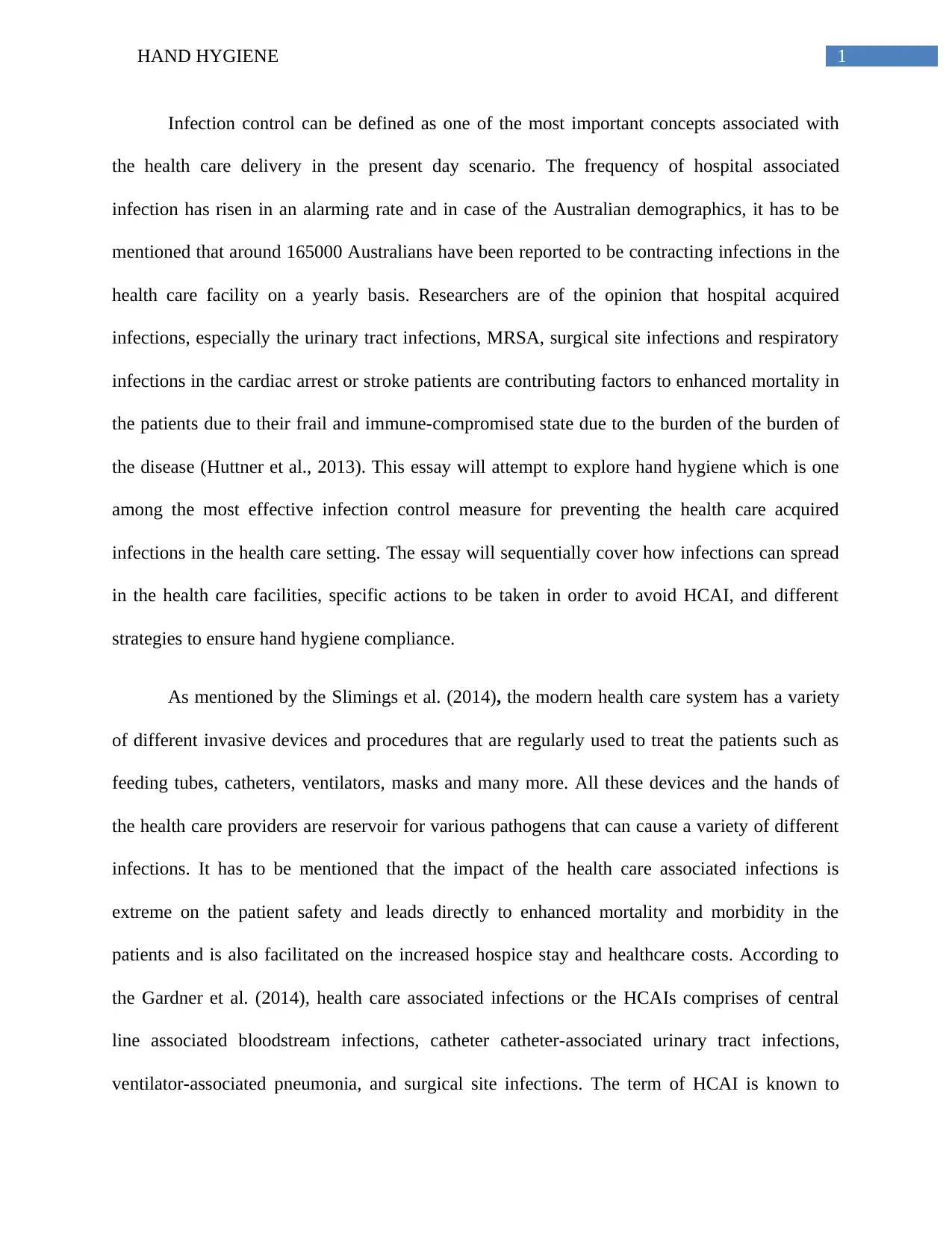
1HAND HYGIENE
Infection control can be defined as one of the most important concepts associated with
the health care delivery in the present day scenario. The frequency of hospital associated
infection has risen in an alarming rate and in case of the Australian demographics, it has to be
mentioned that around 165000 Australians have been reported to be contracting infections in the
health care facility on a yearly basis. Researchers are of the opinion that hospital acquired
infections, especially the urinary tract infections, MRSA, surgical site infections and respiratory
infections in the cardiac arrest or stroke patients are contributing factors to enhanced mortality in
the patients due to their frail and immune-compromised state due to the burden of the burden of
the disease (Huttner et al., 2013). This essay will attempt to explore hand hygiene which is one
among the most effective infection control measure for preventing the health care acquired
infections in the health care setting. The essay will sequentially cover how infections can spread
in the health care facilities, specific actions to be taken in order to avoid HCAI, and different
strategies to ensure hand hygiene compliance.
As mentioned by the Slimings et al. (2014), the modern health care system has a variety
of different invasive devices and procedures that are regularly used to treat the patients such as
feeding tubes, catheters, ventilators, masks and many more. All these devices and the hands of
the health care providers are reservoir for various pathogens that can cause a variety of different
infections. It has to be mentioned that the impact of the health care associated infections is
extreme on the patient safety and leads directly to enhanced mortality and morbidity in the
patients and is also facilitated on the increased hospice stay and healthcare costs. According to
the Gardner et al. (2014), health care associated infections or the HCAIs comprises of central
line associated bloodstream infections, catheter catheter-associated urinary tract infections,
ventilator-associated pneumonia, and surgical site infections. The term of HCAI is known to
Infection control can be defined as one of the most important concepts associated with
the health care delivery in the present day scenario. The frequency of hospital associated
infection has risen in an alarming rate and in case of the Australian demographics, it has to be
mentioned that around 165000 Australians have been reported to be contracting infections in the
health care facility on a yearly basis. Researchers are of the opinion that hospital acquired
infections, especially the urinary tract infections, MRSA, surgical site infections and respiratory
infections in the cardiac arrest or stroke patients are contributing factors to enhanced mortality in
the patients due to their frail and immune-compromised state due to the burden of the burden of
the disease (Huttner et al., 2013). This essay will attempt to explore hand hygiene which is one
among the most effective infection control measure for preventing the health care acquired
infections in the health care setting. The essay will sequentially cover how infections can spread
in the health care facilities, specific actions to be taken in order to avoid HCAI, and different
strategies to ensure hand hygiene compliance.
As mentioned by the Slimings et al. (2014), the modern health care system has a variety
of different invasive devices and procedures that are regularly used to treat the patients such as
feeding tubes, catheters, ventilators, masks and many more. All these devices and the hands of
the health care providers are reservoir for various pathogens that can cause a variety of different
infections. It has to be mentioned that the impact of the health care associated infections is
extreme on the patient safety and leads directly to enhanced mortality and morbidity in the
patients and is also facilitated on the increased hospice stay and healthcare costs. According to
the Gardner et al. (2014), health care associated infections or the HCAIs comprises of central
line associated bloodstream infections, catheter catheter-associated urinary tract infections,
ventilator-associated pneumonia, and surgical site infections. The term of HCAI is known to
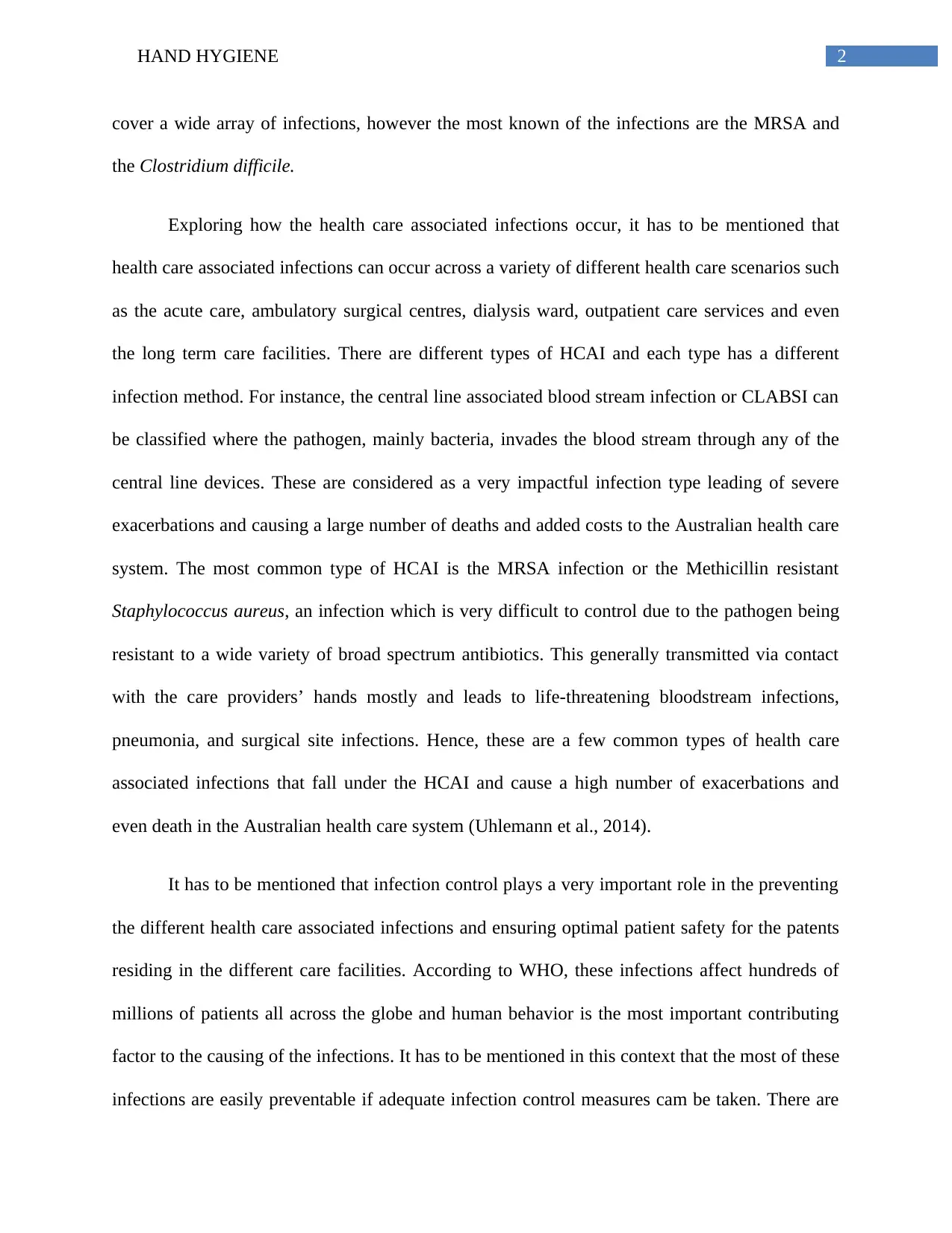
2HAND HYGIENE
cover a wide array of infections, however the most known of the infections are the MRSA and
the Clostridium difficile.
Exploring how the health care associated infections occur, it has to be mentioned that
health care associated infections can occur across a variety of different health care scenarios such
as the acute care, ambulatory surgical centres, dialysis ward, outpatient care services and even
the long term care facilities. There are different types of HCAI and each type has a different
infection method. For instance, the central line associated blood stream infection or CLABSI can
be classified where the pathogen, mainly bacteria, invades the blood stream through any of the
central line devices. These are considered as a very impactful infection type leading of severe
exacerbations and causing a large number of deaths and added costs to the Australian health care
system. The most common type of HCAI is the MRSA infection or the Methicillin resistant
Staphylococcus aureus, an infection which is very difficult to control due to the pathogen being
resistant to a wide variety of broad spectrum antibiotics. This generally transmitted via contact
with the care providers’ hands mostly and leads to life-threatening bloodstream infections,
pneumonia, and surgical site infections. Hence, these are a few common types of health care
associated infections that fall under the HCAI and cause a high number of exacerbations and
even death in the Australian health care system (Uhlemann et al., 2014).
It has to be mentioned that infection control plays a very important role in the preventing
the different health care associated infections and ensuring optimal patient safety for the patents
residing in the different care facilities. According to WHO, these infections affect hundreds of
millions of patients all across the globe and human behavior is the most important contributing
factor to the causing of the infections. It has to be mentioned in this context that the most of these
infections are easily preventable if adequate infection control measures cam be taken. There are
cover a wide array of infections, however the most known of the infections are the MRSA and
the Clostridium difficile.
Exploring how the health care associated infections occur, it has to be mentioned that
health care associated infections can occur across a variety of different health care scenarios such
as the acute care, ambulatory surgical centres, dialysis ward, outpatient care services and even
the long term care facilities. There are different types of HCAI and each type has a different
infection method. For instance, the central line associated blood stream infection or CLABSI can
be classified where the pathogen, mainly bacteria, invades the blood stream through any of the
central line devices. These are considered as a very impactful infection type leading of severe
exacerbations and causing a large number of deaths and added costs to the Australian health care
system. The most common type of HCAI is the MRSA infection or the Methicillin resistant
Staphylococcus aureus, an infection which is very difficult to control due to the pathogen being
resistant to a wide variety of broad spectrum antibiotics. This generally transmitted via contact
with the care providers’ hands mostly and leads to life-threatening bloodstream infections,
pneumonia, and surgical site infections. Hence, these are a few common types of health care
associated infections that fall under the HCAI and cause a high number of exacerbations and
even death in the Australian health care system (Uhlemann et al., 2014).
It has to be mentioned that infection control plays a very important role in the preventing
the different health care associated infections and ensuring optimal patient safety for the patents
residing in the different care facilities. According to WHO, these infections affect hundreds of
millions of patients all across the globe and human behavior is the most important contributing
factor to the causing of the infections. It has to be mentioned in this context that the most of these
infections are easily preventable if adequate infection control measures cam be taken. There are
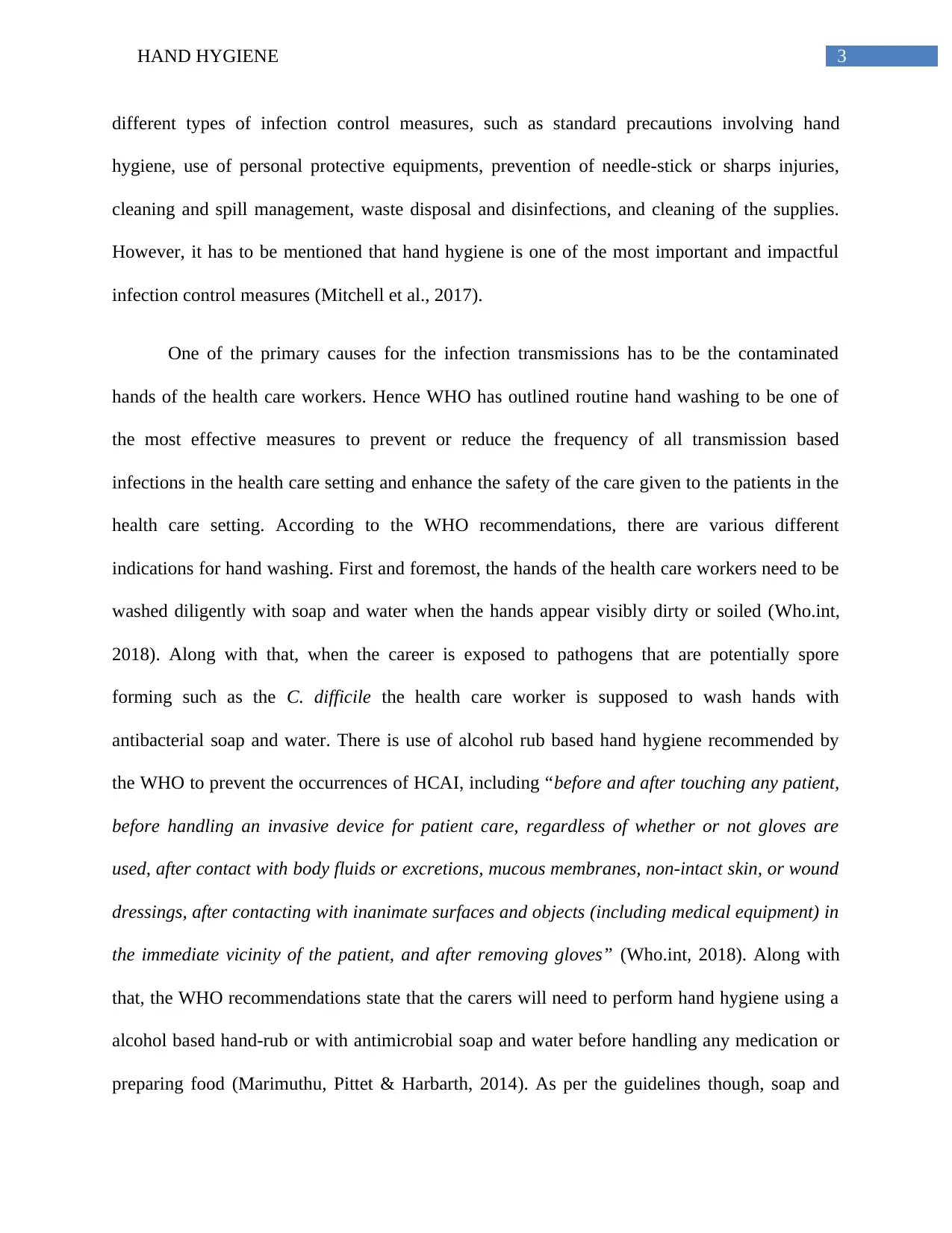
3HAND HYGIENE
different types of infection control measures, such as standard precautions involving hand
hygiene, use of personal protective equipments, prevention of needle-stick or sharps injuries,
cleaning and spill management, waste disposal and disinfections, and cleaning of the supplies.
However, it has to be mentioned that hand hygiene is one of the most important and impactful
infection control measures (Mitchell et al., 2017).
One of the primary causes for the infection transmissions has to be the contaminated
hands of the health care workers. Hence WHO has outlined routine hand washing to be one of
the most effective measures to prevent or reduce the frequency of all transmission based
infections in the health care setting and enhance the safety of the care given to the patients in the
health care setting. According to the WHO recommendations, there are various different
indications for hand washing. First and foremost, the hands of the health care workers need to be
washed diligently with soap and water when the hands appear visibly dirty or soiled (Who.int,
2018). Along with that, when the career is exposed to pathogens that are potentially spore
forming such as the C. difficile the health care worker is supposed to wash hands with
antibacterial soap and water. There is use of alcohol rub based hand hygiene recommended by
the WHO to prevent the occurrences of HCAI, including “before and after touching any patient,
before handling an invasive device for patient care, regardless of whether or not gloves are
used, after contact with body fluids or excretions, mucous membranes, non-intact skin, or wound
dressings, after contacting with inanimate surfaces and objects (including medical equipment) in
the immediate vicinity of the patient, and after removing gloves” (Who.int, 2018). Along with
that, the WHO recommendations state that the carers will need to perform hand hygiene using a
alcohol based hand-rub or with antimicrobial soap and water before handling any medication or
preparing food (Marimuthu, Pittet & Harbarth, 2014). As per the guidelines though, soap and
different types of infection control measures, such as standard precautions involving hand
hygiene, use of personal protective equipments, prevention of needle-stick or sharps injuries,
cleaning and spill management, waste disposal and disinfections, and cleaning of the supplies.
However, it has to be mentioned that hand hygiene is one of the most important and impactful
infection control measures (Mitchell et al., 2017).
One of the primary causes for the infection transmissions has to be the contaminated
hands of the health care workers. Hence WHO has outlined routine hand washing to be one of
the most effective measures to prevent or reduce the frequency of all transmission based
infections in the health care setting and enhance the safety of the care given to the patients in the
health care setting. According to the WHO recommendations, there are various different
indications for hand washing. First and foremost, the hands of the health care workers need to be
washed diligently with soap and water when the hands appear visibly dirty or soiled (Who.int,
2018). Along with that, when the career is exposed to pathogens that are potentially spore
forming such as the C. difficile the health care worker is supposed to wash hands with
antibacterial soap and water. There is use of alcohol rub based hand hygiene recommended by
the WHO to prevent the occurrences of HCAI, including “before and after touching any patient,
before handling an invasive device for patient care, regardless of whether or not gloves are
used, after contact with body fluids or excretions, mucous membranes, non-intact skin, or wound
dressings, after contacting with inanimate surfaces and objects (including medical equipment) in
the immediate vicinity of the patient, and after removing gloves” (Who.int, 2018). Along with
that, the WHO recommendations state that the carers will need to perform hand hygiene using a
alcohol based hand-rub or with antimicrobial soap and water before handling any medication or
preparing food (Marimuthu, Pittet & Harbarth, 2014). As per the guidelines though, soap and
Secure Best Marks with AI Grader
Need help grading? Try our AI Grader for instant feedback on your assignments.
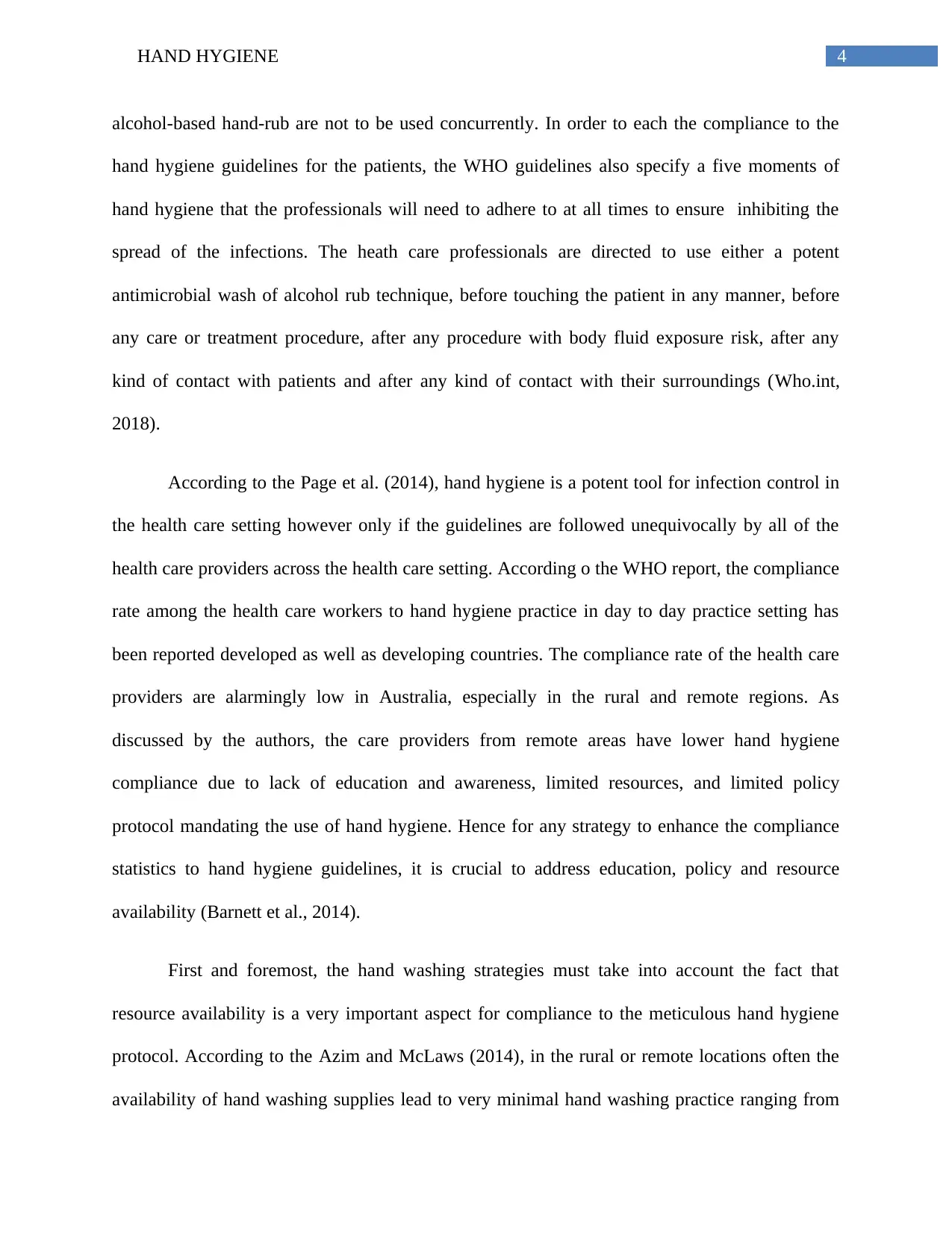
4HAND HYGIENE
alcohol-based hand-rub are not to be used concurrently. In order to each the compliance to the
hand hygiene guidelines for the patients, the WHO guidelines also specify a five moments of
hand hygiene that the professionals will need to adhere to at all times to ensure inhibiting the
spread of the infections. The heath care professionals are directed to use either a potent
antimicrobial wash of alcohol rub technique, before touching the patient in any manner, before
any care or treatment procedure, after any procedure with body fluid exposure risk, after any
kind of contact with patients and after any kind of contact with their surroundings (Who.int,
2018).
According to the Page et al. (2014), hand hygiene is a potent tool for infection control in
the health care setting however only if the guidelines are followed unequivocally by all of the
health care providers across the health care setting. According o the WHO report, the compliance
rate among the health care workers to hand hygiene practice in day to day practice setting has
been reported developed as well as developing countries. The compliance rate of the health care
providers are alarmingly low in Australia, especially in the rural and remote regions. As
discussed by the authors, the care providers from remote areas have lower hand hygiene
compliance due to lack of education and awareness, limited resources, and limited policy
protocol mandating the use of hand hygiene. Hence for any strategy to enhance the compliance
statistics to hand hygiene guidelines, it is crucial to address education, policy and resource
availability (Barnett et al., 2014).
First and foremost, the hand washing strategies must take into account the fact that
resource availability is a very important aspect for compliance to the meticulous hand hygiene
protocol. According to the Azim and McLaws (2014), in the rural or remote locations often the
availability of hand washing supplies lead to very minimal hand washing practice ranging from
alcohol-based hand-rub are not to be used concurrently. In order to each the compliance to the
hand hygiene guidelines for the patients, the WHO guidelines also specify a five moments of
hand hygiene that the professionals will need to adhere to at all times to ensure inhibiting the
spread of the infections. The heath care professionals are directed to use either a potent
antimicrobial wash of alcohol rub technique, before touching the patient in any manner, before
any care or treatment procedure, after any procedure with body fluid exposure risk, after any
kind of contact with patients and after any kind of contact with their surroundings (Who.int,
2018).
According to the Page et al. (2014), hand hygiene is a potent tool for infection control in
the health care setting however only if the guidelines are followed unequivocally by all of the
health care providers across the health care setting. According o the WHO report, the compliance
rate among the health care workers to hand hygiene practice in day to day practice setting has
been reported developed as well as developing countries. The compliance rate of the health care
providers are alarmingly low in Australia, especially in the rural and remote regions. As
discussed by the authors, the care providers from remote areas have lower hand hygiene
compliance due to lack of education and awareness, limited resources, and limited policy
protocol mandating the use of hand hygiene. Hence for any strategy to enhance the compliance
statistics to hand hygiene guidelines, it is crucial to address education, policy and resource
availability (Barnett et al., 2014).
First and foremost, the hand washing strategies must take into account the fact that
resource availability is a very important aspect for compliance to the meticulous hand hygiene
protocol. According to the Azim and McLaws (2014), in the rural or remote locations often the
availability of hand washing supplies lead to very minimal hand washing practice ranging from
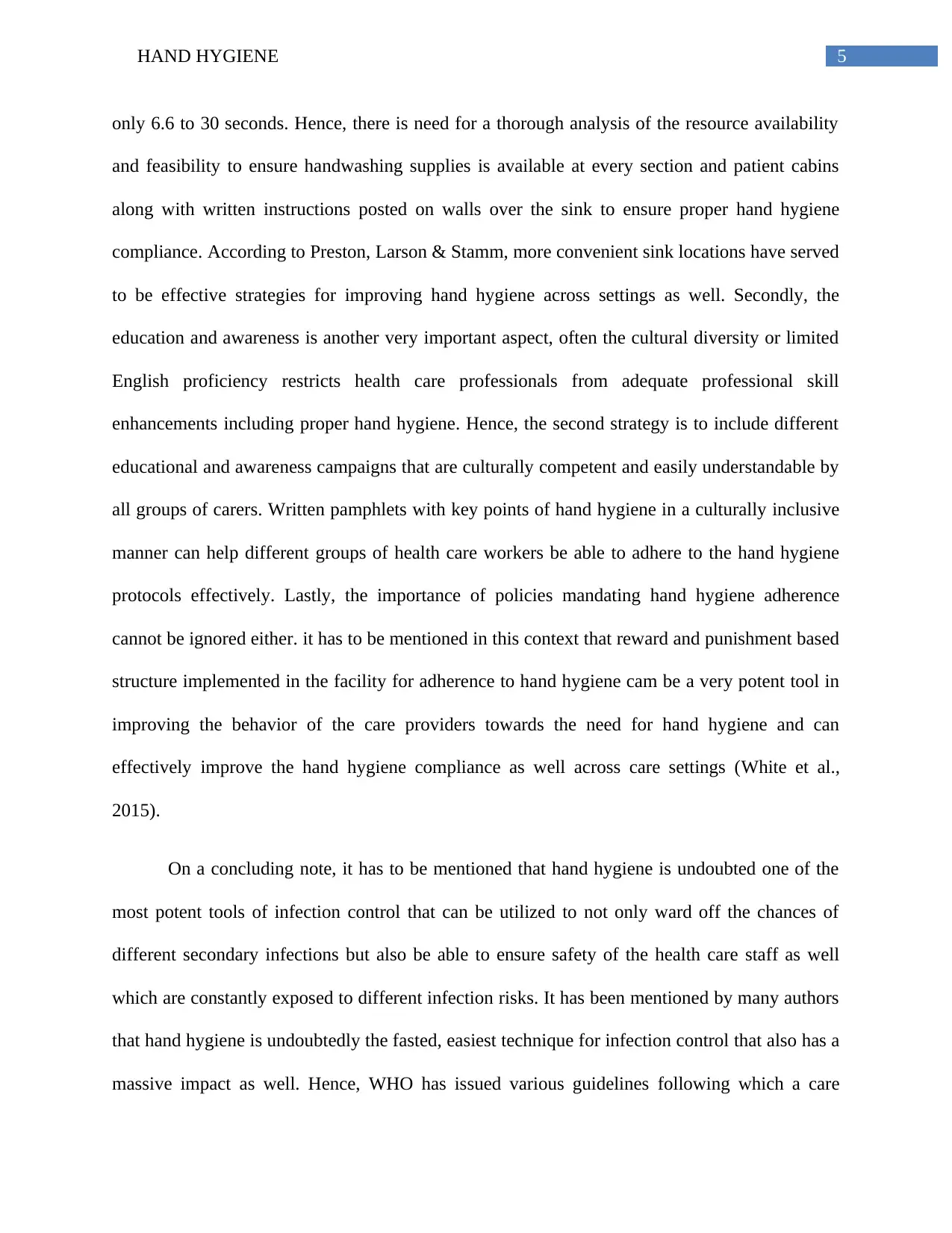
5HAND HYGIENE
only 6.6 to 30 seconds. Hence, there is need for a thorough analysis of the resource availability
and feasibility to ensure handwashing supplies is available at every section and patient cabins
along with written instructions posted on walls over the sink to ensure proper hand hygiene
compliance. According to Preston, Larson & Stamm, more convenient sink locations have served
to be effective strategies for improving hand hygiene across settings as well. Secondly, the
education and awareness is another very important aspect, often the cultural diversity or limited
English proficiency restricts health care professionals from adequate professional skill
enhancements including proper hand hygiene. Hence, the second strategy is to include different
educational and awareness campaigns that are culturally competent and easily understandable by
all groups of carers. Written pamphlets with key points of hand hygiene in a culturally inclusive
manner can help different groups of health care workers be able to adhere to the hand hygiene
protocols effectively. Lastly, the importance of policies mandating hand hygiene adherence
cannot be ignored either. it has to be mentioned in this context that reward and punishment based
structure implemented in the facility for adherence to hand hygiene cam be a very potent tool in
improving the behavior of the care providers towards the need for hand hygiene and can
effectively improve the hand hygiene compliance as well across care settings (White et al.,
2015).
On a concluding note, it has to be mentioned that hand hygiene is undoubted one of the
most potent tools of infection control that can be utilized to not only ward off the chances of
different secondary infections but also be able to ensure safety of the health care staff as well
which are constantly exposed to different infection risks. It has been mentioned by many authors
that hand hygiene is undoubtedly the fasted, easiest technique for infection control that also has a
massive impact as well. Hence, WHO has issued various guidelines following which a care
only 6.6 to 30 seconds. Hence, there is need for a thorough analysis of the resource availability
and feasibility to ensure handwashing supplies is available at every section and patient cabins
along with written instructions posted on walls over the sink to ensure proper hand hygiene
compliance. According to Preston, Larson & Stamm, more convenient sink locations have served
to be effective strategies for improving hand hygiene across settings as well. Secondly, the
education and awareness is another very important aspect, often the cultural diversity or limited
English proficiency restricts health care professionals from adequate professional skill
enhancements including proper hand hygiene. Hence, the second strategy is to include different
educational and awareness campaigns that are culturally competent and easily understandable by
all groups of carers. Written pamphlets with key points of hand hygiene in a culturally inclusive
manner can help different groups of health care workers be able to adhere to the hand hygiene
protocols effectively. Lastly, the importance of policies mandating hand hygiene adherence
cannot be ignored either. it has to be mentioned in this context that reward and punishment based
structure implemented in the facility for adherence to hand hygiene cam be a very potent tool in
improving the behavior of the care providers towards the need for hand hygiene and can
effectively improve the hand hygiene compliance as well across care settings (White et al.,
2015).
On a concluding note, it has to be mentioned that hand hygiene is undoubted one of the
most potent tools of infection control that can be utilized to not only ward off the chances of
different secondary infections but also be able to ensure safety of the health care staff as well
which are constantly exposed to different infection risks. It has been mentioned by many authors
that hand hygiene is undoubtedly the fasted, easiest technique for infection control that also has a
massive impact as well. Hence, WHO has issued various guidelines following which a care
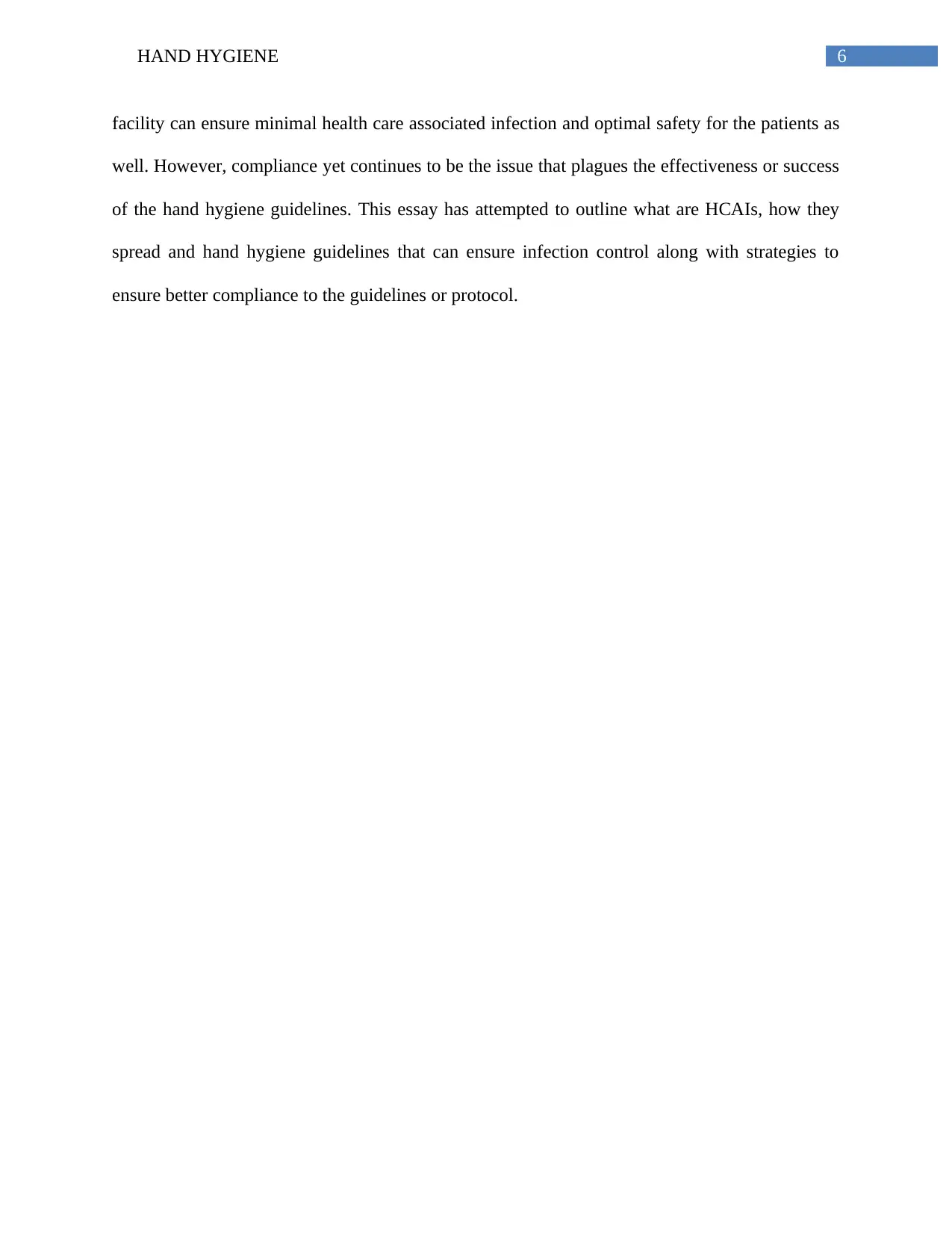
6HAND HYGIENE
facility can ensure minimal health care associated infection and optimal safety for the patients as
well. However, compliance yet continues to be the issue that plagues the effectiveness or success
of the hand hygiene guidelines. This essay has attempted to outline what are HCAIs, how they
spread and hand hygiene guidelines that can ensure infection control along with strategies to
ensure better compliance to the guidelines or protocol.
facility can ensure minimal health care associated infection and optimal safety for the patients as
well. However, compliance yet continues to be the issue that plagues the effectiveness or success
of the hand hygiene guidelines. This essay has attempted to outline what are HCAIs, how they
spread and hand hygiene guidelines that can ensure infection control along with strategies to
ensure better compliance to the guidelines or protocol.
Paraphrase This Document
Need a fresh take? Get an instant paraphrase of this document with our AI Paraphraser
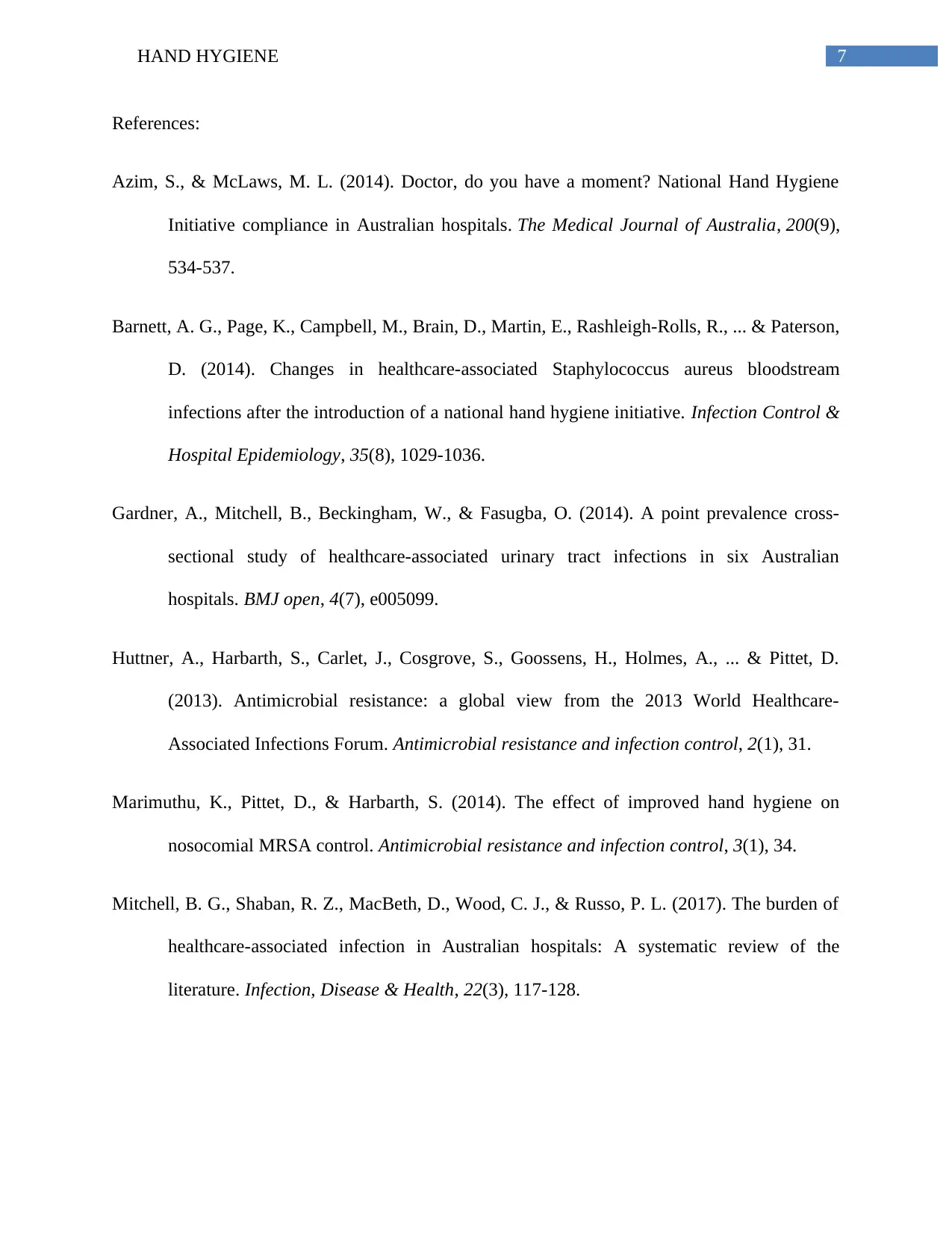
7HAND HYGIENE
References:
Azim, S., & McLaws, M. L. (2014). Doctor, do you have a moment? National Hand Hygiene
Initiative compliance in Australian hospitals. The Medical Journal of Australia, 200(9),
534-537.
Barnett, A. G., Page, K., Campbell, M., Brain, D., Martin, E., Rashleigh-Rolls, R., ... & Paterson,
D. (2014). Changes in healthcare-associated Staphylococcus aureus bloodstream
infections after the introduction of a national hand hygiene initiative. Infection Control &
Hospital Epidemiology, 35(8), 1029-1036.
Gardner, A., Mitchell, B., Beckingham, W., & Fasugba, O. (2014). A point prevalence cross-
sectional study of healthcare-associated urinary tract infections in six Australian
hospitals. BMJ open, 4(7), e005099.
Huttner, A., Harbarth, S., Carlet, J., Cosgrove, S., Goossens, H., Holmes, A., ... & Pittet, D.
(2013). Antimicrobial resistance: a global view from the 2013 World Healthcare-
Associated Infections Forum. Antimicrobial resistance and infection control, 2(1), 31.
Marimuthu, K., Pittet, D., & Harbarth, S. (2014). The effect of improved hand hygiene on
nosocomial MRSA control. Antimicrobial resistance and infection control, 3(1), 34.
Mitchell, B. G., Shaban, R. Z., MacBeth, D., Wood, C. J., & Russo, P. L. (2017). The burden of
healthcare-associated infection in Australian hospitals: A systematic review of the
literature. Infection, Disease & Health, 22(3), 117-128.
References:
Azim, S., & McLaws, M. L. (2014). Doctor, do you have a moment? National Hand Hygiene
Initiative compliance in Australian hospitals. The Medical Journal of Australia, 200(9),
534-537.
Barnett, A. G., Page, K., Campbell, M., Brain, D., Martin, E., Rashleigh-Rolls, R., ... & Paterson,
D. (2014). Changes in healthcare-associated Staphylococcus aureus bloodstream
infections after the introduction of a national hand hygiene initiative. Infection Control &
Hospital Epidemiology, 35(8), 1029-1036.
Gardner, A., Mitchell, B., Beckingham, W., & Fasugba, O. (2014). A point prevalence cross-
sectional study of healthcare-associated urinary tract infections in six Australian
hospitals. BMJ open, 4(7), e005099.
Huttner, A., Harbarth, S., Carlet, J., Cosgrove, S., Goossens, H., Holmes, A., ... & Pittet, D.
(2013). Antimicrobial resistance: a global view from the 2013 World Healthcare-
Associated Infections Forum. Antimicrobial resistance and infection control, 2(1), 31.
Marimuthu, K., Pittet, D., & Harbarth, S. (2014). The effect of improved hand hygiene on
nosocomial MRSA control. Antimicrobial resistance and infection control, 3(1), 34.
Mitchell, B. G., Shaban, R. Z., MacBeth, D., Wood, C. J., & Russo, P. L. (2017). The burden of
healthcare-associated infection in Australian hospitals: A systematic review of the
literature. Infection, Disease & Health, 22(3), 117-128.
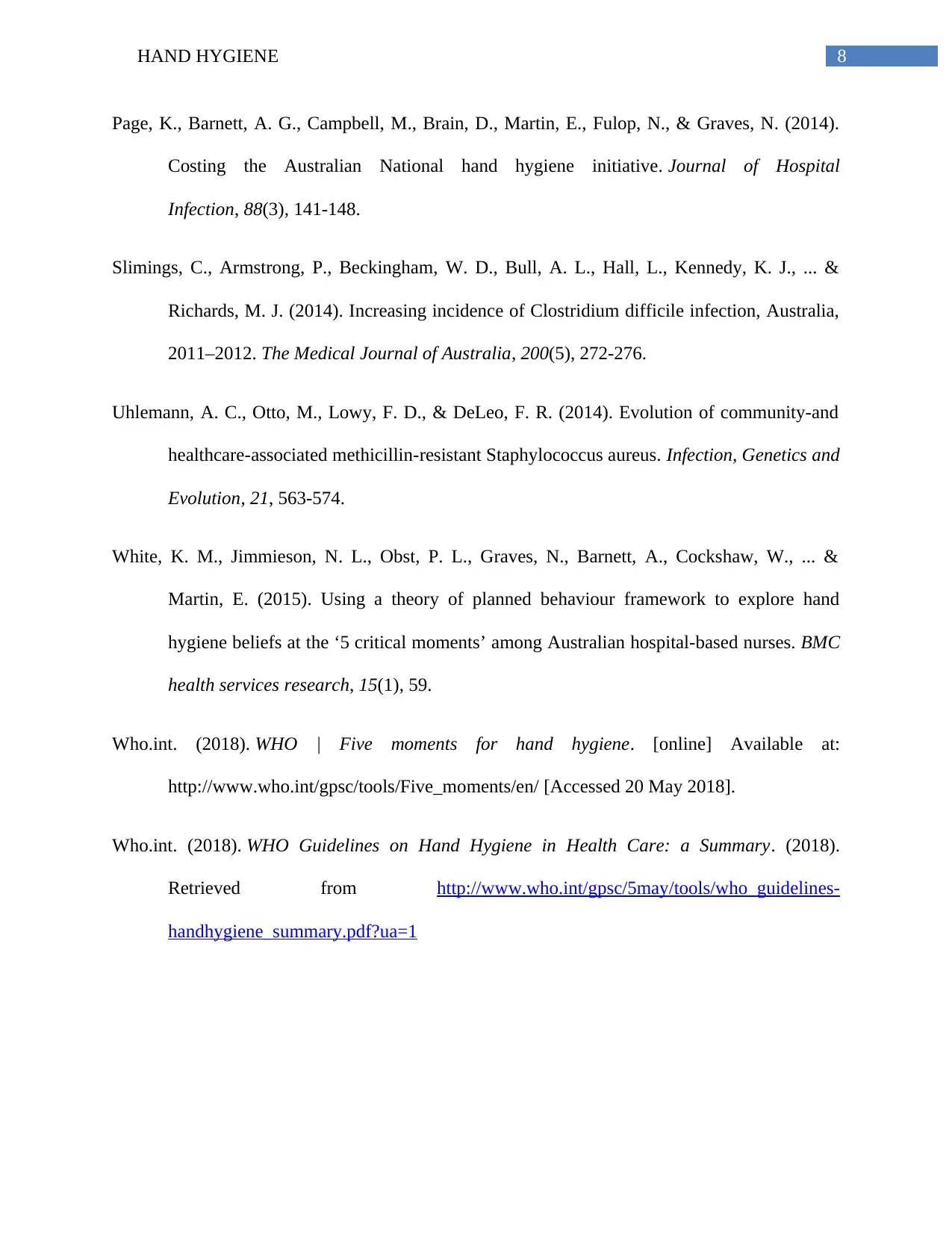
8HAND HYGIENE
Page, K., Barnett, A. G., Campbell, M., Brain, D., Martin, E., Fulop, N., & Graves, N. (2014).
Costing the Australian National hand hygiene initiative. Journal of Hospital
Infection, 88(3), 141-148.
Slimings, C., Armstrong, P., Beckingham, W. D., Bull, A. L., Hall, L., Kennedy, K. J., ... &
Richards, M. J. (2014). Increasing incidence of Clostridium difficile infection, Australia,
2011–2012. The Medical Journal of Australia, 200(5), 272-276.
Uhlemann, A. C., Otto, M., Lowy, F. D., & DeLeo, F. R. (2014). Evolution of community-and
healthcare-associated methicillin-resistant Staphylococcus aureus. Infection, Genetics and
Evolution, 21, 563-574.
White, K. M., Jimmieson, N. L., Obst, P. L., Graves, N., Barnett, A., Cockshaw, W., ... &
Martin, E. (2015). Using a theory of planned behaviour framework to explore hand
hygiene beliefs at the ‘5 critical moments’ among Australian hospital-based nurses. BMC
health services research, 15(1), 59.
Who.int. (2018). WHO | Five moments for hand hygiene. [online] Available at:
http://www.who.int/gpsc/tools/Five_moments/en/ [Accessed 20 May 2018].
Who.int. (2018). WHO Guidelines on Hand Hygiene in Health Care: a Summary. (2018).
Retrieved from http://www.who.int/gpsc/5may/tools/who_guidelines-
handhygiene_summary.pdf?ua=1
Page, K., Barnett, A. G., Campbell, M., Brain, D., Martin, E., Fulop, N., & Graves, N. (2014).
Costing the Australian National hand hygiene initiative. Journal of Hospital
Infection, 88(3), 141-148.
Slimings, C., Armstrong, P., Beckingham, W. D., Bull, A. L., Hall, L., Kennedy, K. J., ... &
Richards, M. J. (2014). Increasing incidence of Clostridium difficile infection, Australia,
2011–2012. The Medical Journal of Australia, 200(5), 272-276.
Uhlemann, A. C., Otto, M., Lowy, F. D., & DeLeo, F. R. (2014). Evolution of community-and
healthcare-associated methicillin-resistant Staphylococcus aureus. Infection, Genetics and
Evolution, 21, 563-574.
White, K. M., Jimmieson, N. L., Obst, P. L., Graves, N., Barnett, A., Cockshaw, W., ... &
Martin, E. (2015). Using a theory of planned behaviour framework to explore hand
hygiene beliefs at the ‘5 critical moments’ among Australian hospital-based nurses. BMC
health services research, 15(1), 59.
Who.int. (2018). WHO | Five moments for hand hygiene. [online] Available at:
http://www.who.int/gpsc/tools/Five_moments/en/ [Accessed 20 May 2018].
Who.int. (2018). WHO Guidelines on Hand Hygiene in Health Care: a Summary. (2018).
Retrieved from http://www.who.int/gpsc/5may/tools/who_guidelines-
handhygiene_summary.pdf?ua=1
1 out of 9
Related Documents
Your All-in-One AI-Powered Toolkit for Academic Success.
+13062052269
info@desklib.com
Available 24*7 on WhatsApp / Email
![[object Object]](/_next/static/media/star-bottom.7253800d.svg)
Unlock your academic potential
© 2024 | Zucol Services PVT LTD | All rights reserved.





